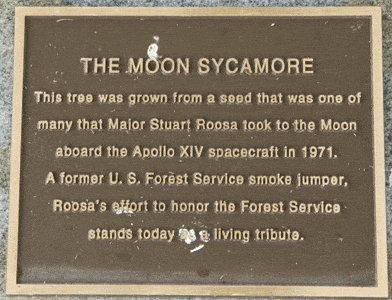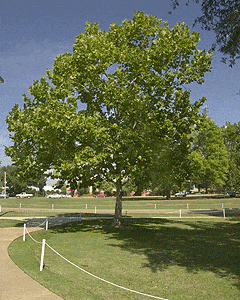Moon trees are grown from seeds that have traveled to the moon or orbited it. Mississippi is home to at least three moon trees in Starkville and Cleveland. These trees foster educational opportunities for the communities and the U.S. Forest Service.
The first moon trees came from seeds collected by the Forest Service that flew around the moon during the Apollo 14 mission in 1971. Those seeds orbited the moon 34 times. After returning to Earth, the Forest Service germinated the seeds and planted the resulting seedlings in various places worldwide.

In 1975, astronaut Stuart Roosa planted a sycamore tree at Dorman Hall on the Mississippi State University campus in Starkville, Mississippi. The tree is known as the “moon sycamore” and is a tribute to Roosa and the Apollo program. A sign on Mississippi State’s “Moon Sycamore” identifies the famed tree as an American Sycamore. Seeds from MSU’s moon tree have contributed to many new Moon Sycamore trees. Twelve have been planted at Kennedy Space Center as NASA began its Apollo anniversary celebration.
An article in the March 14, 1976, Mississippi Clarion-Ledger entitled “Seeds Went to Moon, Tree to DSU Campus” discusses and shows a picture of a sycamore seedling Moon Tree acquired by Delta State University from the Institute of Forest Genetics at Gulfport, Mississippi. The article says the seedling “will soon be planted” and quotes DSU professor of biology Dr. Mabel Raspet that “Delta State’s “moon tree” will be planted somewhere on the DSU campus.” No further information on the tree, its planting date, location, history, and current status are known.
But the other moon tree in Cleveland, Mississippi, isn’t a mystery and is being celebrated. Bayou Academy in Cleveland, MS, received a sweetgum that traveled 270,000 miles around the moon aboard the Orion spacecraft in 2022. Bayou Academy is one of only a few institutions NASA chose to receive seeds. In addition, Thomas Logan, a Bayou Academy sophomore, built a protective barrier around the tree as part of his BSA Eagle Scout project, ensuring its conservation.

The trees have always been used in scientific experiments to determine if seeds could grow normally after being in microgravity for an extended time. The experiment showed that the seeds developed without problems and were similar to trees grown on Earth, indicating that extended exposure to low and zero gravity doesn’t stunt plant growth.

While moon trees look like trees to the average eye, they are unique because of the conversations they spark and the awe and wonder they evoke. Students and visitors on these Mississippi campuses will imagine what it took regarding science, technology, engineering, and mathematics (STEM) to get those seeds to the moon and back. If nothing else, it’s a really cool story to share!
The Moon Trees symbolize a unique piece of science history that Mississippi gets to share in.




